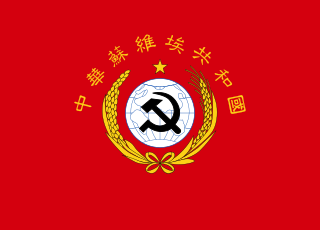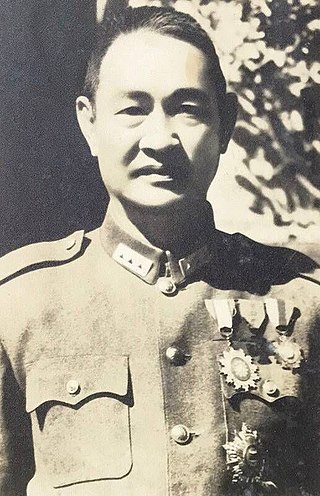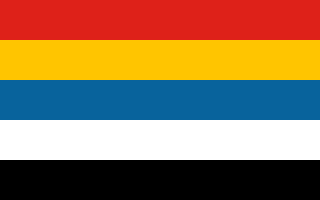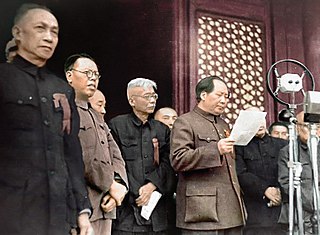
The Chinese Civil War was fought between the Kuomintang-led government of the Republic of China and the forces of the Chinese Communist Party (CCP),with armed conflict continuing intermittently from 1 August 1927 until Communist victory resulted in their total control over mainland China on 7 December 1949.

The Long March was a military retreat by the Chinese Red Army from advancing Nationalist forces during the Chinese Civil War in 1934 through to 1936.

The Chinese Soviet Republic (CSR) was a state within China,proclaimed on 7 November 1931 by Chinese Communist Party (CCP) leaders Mao Zedong and Zhu De in the early stages of the Chinese Civil War. The discontiguous territories of the CSR included 18 provinces and 4 counties under the Communists' control. The CSR's government was located in its largest component territory,the Jiangxi Soviet. Due to the importance of the Jiangxi Soviet in the CSR's early history,the name "Jiangxi Soviet" is sometimes used to refer to the CSR as a whole. Other component territories of the CSR included the Northeastern Jiangxi,Hunan-Jiangxi,Hunan-Hubei-Jiangxi,Hunan-Western Hubei,Hunan-Hubei-Sichuan-Guizhou,Eyuwan,Shaanxi-Gansu,Sichuan-Shanxi,and Haifeng-Lufeng Soviets.

Xu Xiangqian was a Marshal of the People's Republic of China (PRC). He was the son of a wealthy landowner,but joined the Kuomintang's (KMT) National Revolutionary Army (NRA),against his parents' wishes,in 1924. When the Chinese Civil War started in 1927,Xu joined the Eyuwan Soviet led by Zhang Guotao;Xu became commander of the Eyuwan-based Fourth Red Army. Zhang and Xu retreated to northern Sichuan after being defeated by a KMT encirclement campaign. Xu politically survived Zhang's defection to the KMT in the late-1930s;he rejoined the Red Army in a less senior position under the leadership of Mao Zedong.

Chen Boda,was a Chinese Communist journalist,professor and political theorist who rose to power as the chief interpreter of Maoism in the first 20 years of the People's Republic of China. Chen became a close associate of Mao Zedong in Yan'an,during the late 1930s,drafting speeches and theoretical essays and directing propaganda.

He Long was a Chinese Communist revolutionary and a Marshal of the People's Republic of China. He was from a poor rural family in Hunan,and his family was not able to provide him with any formal education. He began his revolutionary career after avenging the death of his uncle,when he fled to become an outlaw and attracted a small personal army around him. Later his forces joined the Kuomintang,and he participated in the Northern Expedition.
The yuan is the base unit of a number of former and present-day currencies in Chinese.
The history of the People's Liberation Army began in 1927 with the start of the Chinese Civil War and spans to the present,having developed from a peasant guerrilla force into the largest armed force in the world.

The Nationalist government,officially the National Government of the Republic of China,refers to the government of the Republic of China from 1 July 1925 to 20 May 1948,led by the nationalist Kuomintang (KMT) party.

Zhang Zhizhong or Chang Chih-chung was a Chinese military commander and politician,general in the National Revolutionary Army of the Republic of China and later a pro-Communist politician in the People's Republic of China.

Sino-Soviet relations,or China–Soviet Union relations,refers to the diplomatic relationship between China and the various forms of Soviet Power which emerged from the Russian Revolution of 1917 to 1991,when the Soviet Union ceased to exist.

The Shanghai massacre of 12 April 1927,the April 12 Purge or the April 12 Incident as it is commonly known in China,was the violent suppression of Chinese Communist Party (CCP) organizations and leftist elements in Shanghai by forces supporting General Chiang Kai-shek and conservative factions in the Kuomintang. Following the incident,conservative KMT elements carried out a full-scale purge of communists in all areas under their control,and violent suppression occurred in Guangzhou and Changsha. The purge led to an open split between left-wing and right-wing factions in the KMT,with Chiang Kai-shek establishing himself as the leader of the right-wing faction based in Nanjing,in opposition to the original left-wing KMT government based in Wuhan,which was led by Wang Jingwei. By 15 July 1927,the Wuhan regime had expelled the Communists in its ranks,effectively ending the First United Front,a working alliance of both the KMT and CCP under the tutelage of Comintern agents. For the rest of 1927,the CCP would fight to regain power,beginning the Autumn Harvest Uprising. With the failure and the crushing of the Guangzhou Uprising at Guangzhou however,the power of the Communists was largely diminished,unable to launch another major urban offensive.
The history of the Chinese Communist Party began with its establishment in July 1921. A study group led by Peking University professors Chen Duxiu and Li Dazhao to discuss Marxism,led to intellectuals officially founding the Chinese Communist Party (CCP) in July 1921. In 1923,Sun Yat-sen invited the CCP to form a United Front,and to join his nationalist party,the Kuomintang (KMT),in Canton for training under representatives of the Communist International,the Soviet Union's international organization. The Soviet representatives reorganized both parties into Leninist parties. Rather than the loose organization that characterized the two parties until then,the Leninist party operated on the principle of democratic centralism,in which the collective leadership set standards for membership and an all-powerful Central Committee determined the party line,which all members must follow.

After the fall of the Qing dynasty in 1912,China underwent a period of instability and disrupted economic activity. During the Nanjing decade (1927–1937),China advanced in a number of industrial sectors,in particular those related to the military,in an effort to catch up with the west and prepare for war with Japan. The Second Sino-Japanese War (1937–1945) and the following Chinese civil war caused the retreat of the Republic of China and formation of the People's Republic of China.

Cheng Qian was a Chinese army officer and politician who held important military and political positions in both the Republic of China and the People's Republic of China. Educated at the Imperial Japanese Army Academy and Waseda University,he first met Sun Yat-sen in Tokyo,becoming an early supporter. Later,under Chiang Kai-shek,he was one of the most powerful members of the Kuomintang,notably serving as Chief of Staff of the Military Affairs Commission during the Second Sino–Japanese War.

The Republic of China (ROC) began as a country in mainland China. It was established on 1 January 1912 after the 1911 Revolution,which overthrew the Manchu-led Qing dynasty and ended China's imperial history. It was ruled by the Kuomintang (KMT) as a one-party state while headquartered in Nanjing from 1927 until its relocation to Taiwan on 7 December 1949,following its defeat by the Chinese Communist Party (CCP) in the Chinese Civil War. The CCP proclaimed the People's Republic of China (PRC) on 1 October 1949,while the ROC retains control over the "Taiwan Area" and the political status of Taiwan remains in dispute.

The Chinese Communist Party (CCP) had sphere of influence zones within Republican era China from 1927 to 1949 during the Chinese Civil War,collectively called revolutionary base areas. They were also known as the Soviet Zone from 1927 to 1937 during the early stages of the Chinese Civil War,the Anti-Japanese Base Areas during the Second Sino-Japanese War,and the Liberated Zone during the final Stages of the Civil War from 1946 until the founding of the People's Republic of China in 1949.

The Chinese Communist Revolution was a social revolution in China that began in 1927 and culminated with the proclamation of the People's Republic of China (PRC) in 1949. For the preceding century,termed the century of humiliation,China had faced escalating social,economic,and political problems as a result of Western and Japanese imperialism,and the decline of the Qing dynasty (1644–1912). Cyclical famines and an oppressive landlord system kept the large mass of rural peasantry poor and politically disenfranchised. The Chinese Communist Party (CCP) was formed by young urban intellectuals in 1921,inspired by European socialist ideas and the success of the Russian October Revolution in 1917. In the First United Front,the Communists initially allied themselves with the nationalist Kuomintang (KMT) against the forces of local warlords and foreign imperialists,but the 1927 Shanghai massacre targeting Communists ordered by KMT leader Chiang Kai-shek marked the start of the Chinese Civil War between Nationalists and Communists that would ultimately last more than three decades.

Liu Shaoqi was a Chinese revolutionary and politician. He was the chairman of the Standing Committee of the National People's Congress from 1954 to 1959,first-ranking vice chairman of the Chinese Communist Party from 1956 to 1966,and the chairman of the People's Republic of China,the head of state from 1959 to 1968. He was considered to be a possible successor to Mao Zedong,but was purged during the Cultural Revolution.

The proclamation of the People's Republic of China was made by Mao Zedong,the Chairman of the Chinese Communist Party (CCP),on October 1,1949,in Tiananmen Square in Beijing. The government of a new state under the CCP,formally called the Central People's Government,was proclaimed by Mao at the ceremony,which marked the foundation of the People's Republic of China.

















